Exploring Business Law: Sources, Government Role, and Business Impact
VerifiedAdded on 2023/06/05
|12
|4497
|459
Report
AI Summary
This report provides a detailed overview of business law, exploring its various sources including legislation, case law, European Union laws, and the European Convention of Human Rights. It examines the role of the UK government in law-making, focusing on the application of statutory and common law in justice courts. The effectiveness of the legal system is evaluated, considering its strengths and limitations. Examples are used to illustrate the potential impact of company, employment, and contract law on businesses, and the impact on business is analyzed through a differentiation between legislation, regulations, and standards. Furthermore, the report explores different types of business organizations, their legal formation, management, and funding, supported by case studies. Desklib offers a platform for students to access this and other solved assignments for their study needs.
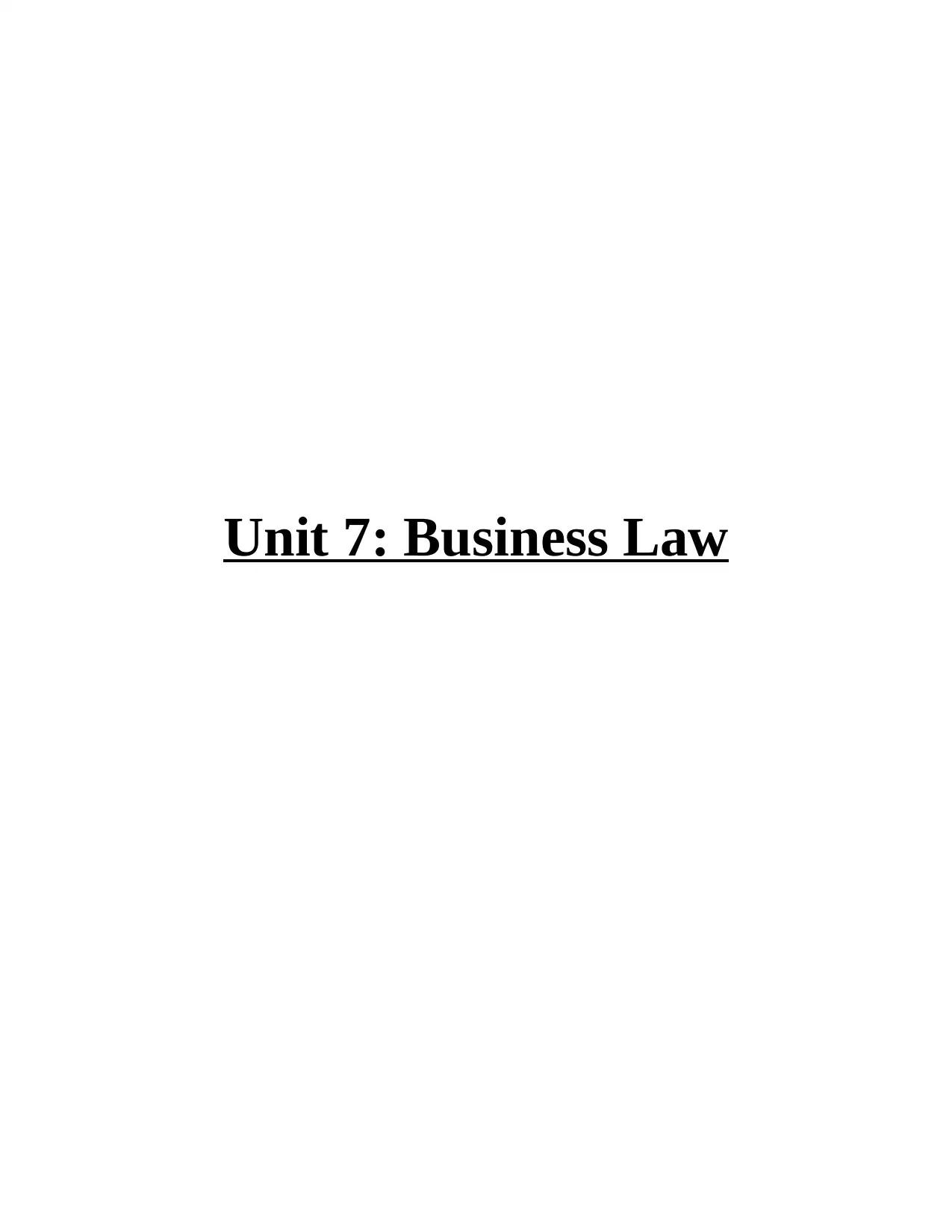
Unit 7: Business Law
Paraphrase This Document
Need a fresh take? Get an instant paraphrase of this document with our AI Paraphraser
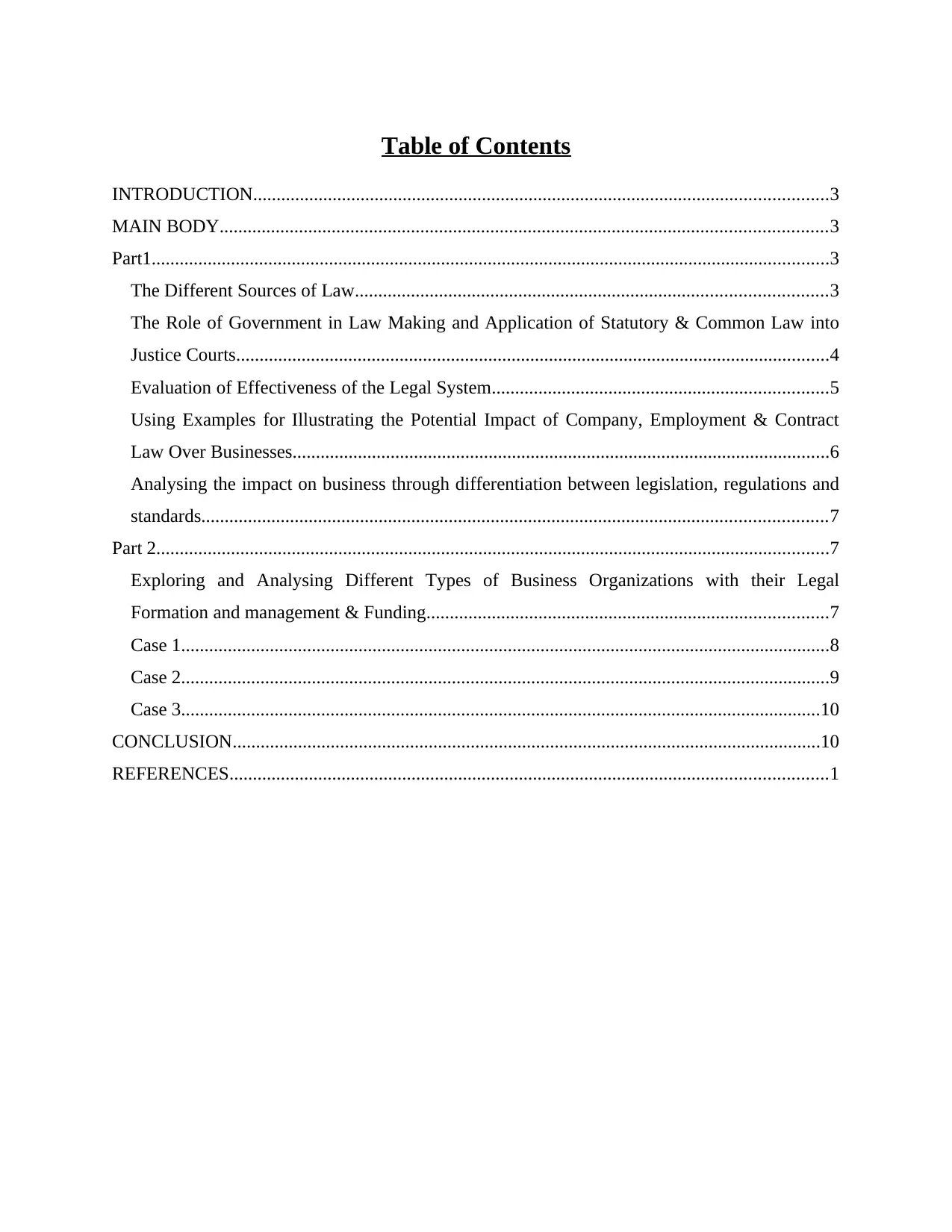
Table of Contents
INTRODUCTION...........................................................................................................................3
MAIN BODY..................................................................................................................................3
Part1.................................................................................................................................................3
The Different Sources of Law.....................................................................................................3
The Role of Government in Law Making and Application of Statutory & Common Law into
Justice Courts...............................................................................................................................4
Evaluation of Effectiveness of the Legal System........................................................................5
Using Examples for Illustrating the Potential Impact of Company, Employment & Contract
Law Over Businesses...................................................................................................................6
Analysing the impact on business through differentiation between legislation, regulations and
standards......................................................................................................................................7
Part 2................................................................................................................................................7
Exploring and Analysing Different Types of Business Organizations with their Legal
Formation and management & Funding......................................................................................7
Case 1...........................................................................................................................................8
Case 2...........................................................................................................................................9
Case 3.........................................................................................................................................10
CONCLUSION..............................................................................................................................10
REFERENCES................................................................................................................................1
INTRODUCTION...........................................................................................................................3
MAIN BODY..................................................................................................................................3
Part1.................................................................................................................................................3
The Different Sources of Law.....................................................................................................3
The Role of Government in Law Making and Application of Statutory & Common Law into
Justice Courts...............................................................................................................................4
Evaluation of Effectiveness of the Legal System........................................................................5
Using Examples for Illustrating the Potential Impact of Company, Employment & Contract
Law Over Businesses...................................................................................................................6
Analysing the impact on business through differentiation between legislation, regulations and
standards......................................................................................................................................7
Part 2................................................................................................................................................7
Exploring and Analysing Different Types of Business Organizations with their Legal
Formation and management & Funding......................................................................................7
Case 1...........................................................................................................................................8
Case 2...........................................................................................................................................9
Case 3.........................................................................................................................................10
CONCLUSION..............................................................................................................................10
REFERENCES................................................................................................................................1
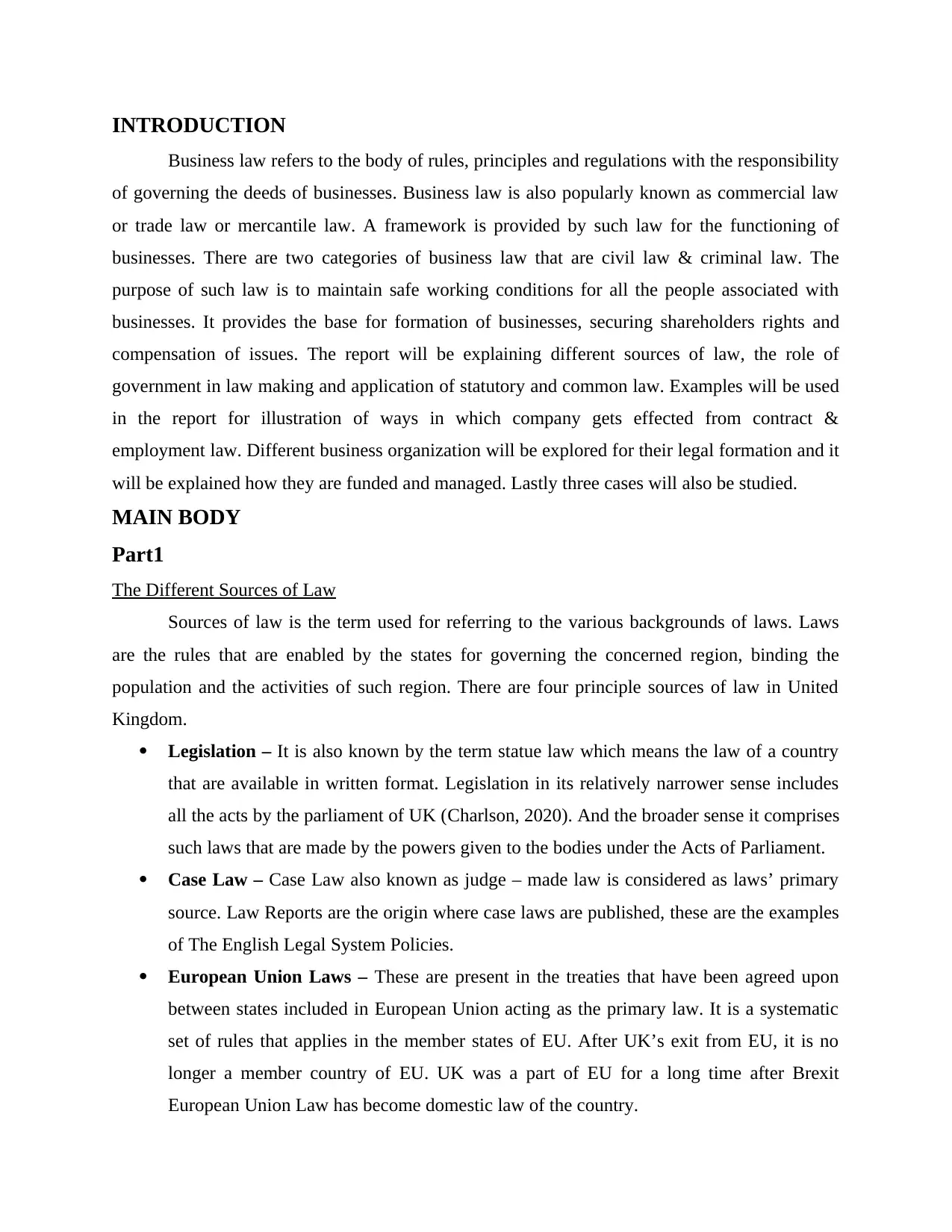
INTRODUCTION
Business law refers to the body of rules, principles and regulations with the responsibility
of governing the deeds of businesses. Business law is also popularly known as commercial law
or trade law or mercantile law. A framework is provided by such law for the functioning of
businesses. There are two categories of business law that are civil law & criminal law. The
purpose of such law is to maintain safe working conditions for all the people associated with
businesses. It provides the base for formation of businesses, securing shareholders rights and
compensation of issues. The report will be explaining different sources of law, the role of
government in law making and application of statutory and common law. Examples will be used
in the report for illustration of ways in which company gets effected from contract &
employment law. Different business organization will be explored for their legal formation and it
will be explained how they are funded and managed. Lastly three cases will also be studied.
MAIN BODY
Part1
The Different Sources of Law
Sources of law is the term used for referring to the various backgrounds of laws. Laws
are the rules that are enabled by the states for governing the concerned region, binding the
population and the activities of such region. There are four principle sources of law in United
Kingdom.
Legislation – It is also known by the term statue law which means the law of a country
that are available in written format. Legislation in its relatively narrower sense includes
all the acts by the parliament of UK (Charlson, 2020). And the broader sense it comprises
such laws that are made by the powers given to the bodies under the Acts of Parliament.
Case Law – Case Law also known as judge – made law is considered as laws’ primary
source. Law Reports are the origin where case laws are published, these are the examples
of The English Legal System Policies.
European Union Laws – These are present in the treaties that have been agreed upon
between states included in European Union acting as the primary law. It is a systematic
set of rules that applies in the member states of EU. After UK’s exit from EU, it is no
longer a member country of EU. UK was a part of EU for a long time after Brexit
European Union Law has become domestic law of the country.
Business law refers to the body of rules, principles and regulations with the responsibility
of governing the deeds of businesses. Business law is also popularly known as commercial law
or trade law or mercantile law. A framework is provided by such law for the functioning of
businesses. There are two categories of business law that are civil law & criminal law. The
purpose of such law is to maintain safe working conditions for all the people associated with
businesses. It provides the base for formation of businesses, securing shareholders rights and
compensation of issues. The report will be explaining different sources of law, the role of
government in law making and application of statutory and common law. Examples will be used
in the report for illustration of ways in which company gets effected from contract &
employment law. Different business organization will be explored for their legal formation and it
will be explained how they are funded and managed. Lastly three cases will also be studied.
MAIN BODY
Part1
The Different Sources of Law
Sources of law is the term used for referring to the various backgrounds of laws. Laws
are the rules that are enabled by the states for governing the concerned region, binding the
population and the activities of such region. There are four principle sources of law in United
Kingdom.
Legislation – It is also known by the term statue law which means the law of a country
that are available in written format. Legislation in its relatively narrower sense includes
all the acts by the parliament of UK (Charlson, 2020). And the broader sense it comprises
such laws that are made by the powers given to the bodies under the Acts of Parliament.
Case Law – Case Law also known as judge – made law is considered as laws’ primary
source. Law Reports are the origin where case laws are published, these are the examples
of The English Legal System Policies.
European Union Laws – These are present in the treaties that have been agreed upon
between states included in European Union acting as the primary law. It is a systematic
set of rules that applies in the member states of EU. After UK’s exit from EU, it is no
longer a member country of EU. UK was a part of EU for a long time after Brexit
European Union Law has become domestic law of the country.
⊘ This is a preview!⊘
Do you want full access?
Subscribe today to unlock all pages.

Trusted by 1+ million students worldwide
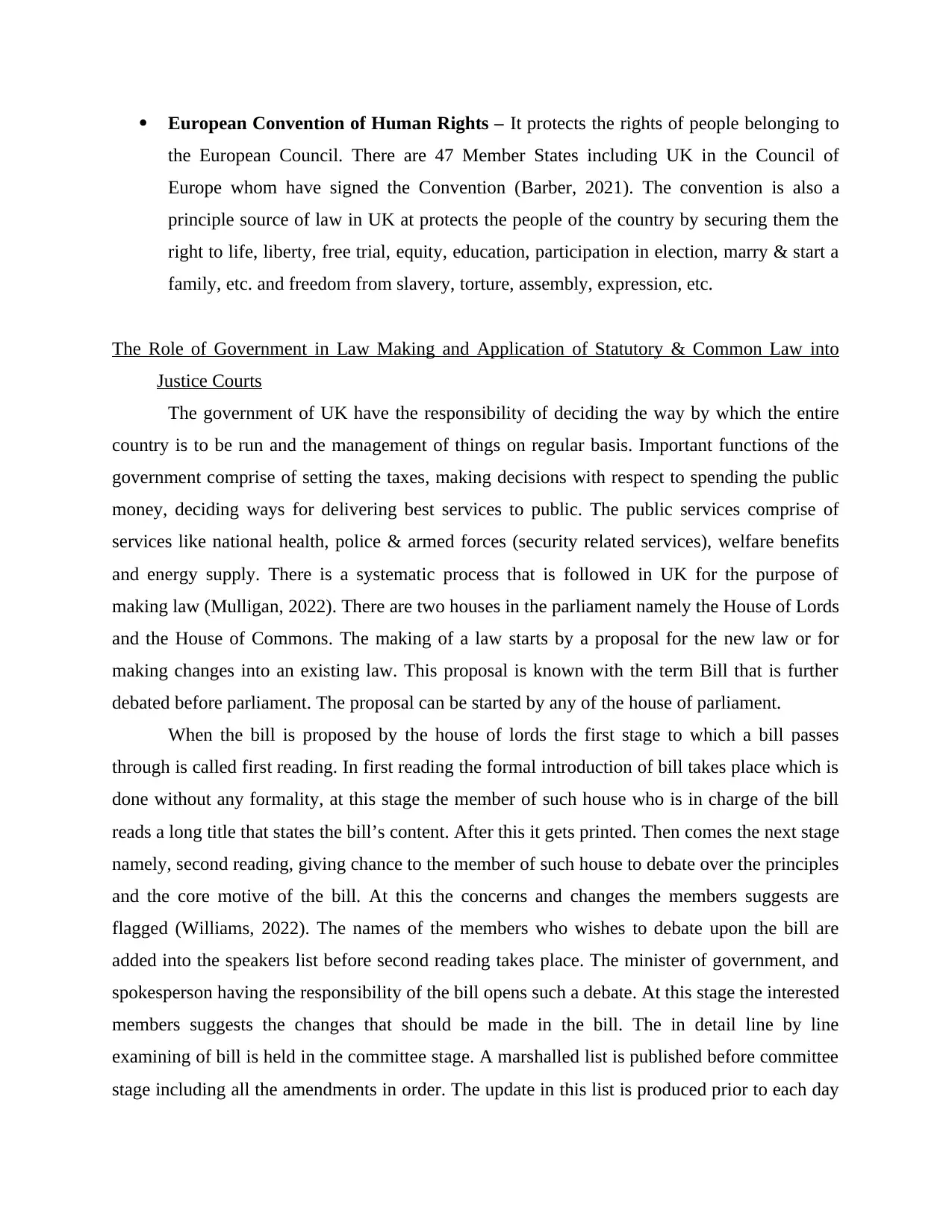
European Convention of Human Rights – It protects the rights of people belonging to
the European Council. There are 47 Member States including UK in the Council of
Europe whom have signed the Convention (Barber, 2021). The convention is also a
principle source of law in UK at protects the people of the country by securing them the
right to life, liberty, free trial, equity, education, participation in election, marry & start a
family, etc. and freedom from slavery, torture, assembly, expression, etc.
The Role of Government in Law Making and Application of Statutory & Common Law into
Justice Courts
The government of UK have the responsibility of deciding the way by which the entire
country is to be run and the management of things on regular basis. Important functions of the
government comprise of setting the taxes, making decisions with respect to spending the public
money, deciding ways for delivering best services to public. The public services comprise of
services like national health, police & armed forces (security related services), welfare benefits
and energy supply. There is a systematic process that is followed in UK for the purpose of
making law (Mulligan, 2022). There are two houses in the parliament namely the House of Lords
and the House of Commons. The making of a law starts by a proposal for the new law or for
making changes into an existing law. This proposal is known with the term Bill that is further
debated before parliament. The proposal can be started by any of the house of parliament.
When the bill is proposed by the house of lords the first stage to which a bill passes
through is called first reading. In first reading the formal introduction of bill takes place which is
done without any formality, at this stage the member of such house who is in charge of the bill
reads a long title that states the bill’s content. After this it gets printed. Then comes the next stage
namely, second reading, giving chance to the member of such house to debate over the principles
and the core motive of the bill. At this the concerns and changes the members suggests are
flagged (Williams, 2022). The names of the members who wishes to debate upon the bill are
added into the speakers list before second reading takes place. The minister of government, and
spokesperson having the responsibility of the bill opens such a debate. At this stage the interested
members suggests the changes that should be made in the bill. The in detail line by line
examining of bill is held in the committee stage. A marshalled list is published before committee
stage including all the amendments in order. The update in this list is produced prior to each day
the European Council. There are 47 Member States including UK in the Council of
Europe whom have signed the Convention (Barber, 2021). The convention is also a
principle source of law in UK at protects the people of the country by securing them the
right to life, liberty, free trial, equity, education, participation in election, marry & start a
family, etc. and freedom from slavery, torture, assembly, expression, etc.
The Role of Government in Law Making and Application of Statutory & Common Law into
Justice Courts
The government of UK have the responsibility of deciding the way by which the entire
country is to be run and the management of things on regular basis. Important functions of the
government comprise of setting the taxes, making decisions with respect to spending the public
money, deciding ways for delivering best services to public. The public services comprise of
services like national health, police & armed forces (security related services), welfare benefits
and energy supply. There is a systematic process that is followed in UK for the purpose of
making law (Mulligan, 2022). There are two houses in the parliament namely the House of Lords
and the House of Commons. The making of a law starts by a proposal for the new law or for
making changes into an existing law. This proposal is known with the term Bill that is further
debated before parliament. The proposal can be started by any of the house of parliament.
When the bill is proposed by the house of lords the first stage to which a bill passes
through is called first reading. In first reading the formal introduction of bill takes place which is
done without any formality, at this stage the member of such house who is in charge of the bill
reads a long title that states the bill’s content. After this it gets printed. Then comes the next stage
namely, second reading, giving chance to the member of such house to debate over the principles
and the core motive of the bill. At this the concerns and changes the members suggests are
flagged (Williams, 2022). The names of the members who wishes to debate upon the bill are
added into the speakers list before second reading takes place. The minister of government, and
spokesperson having the responsibility of the bill opens such a debate. At this stage the interested
members suggests the changes that should be made in the bill. The in detail line by line
examining of bill is held in the committee stage. A marshalled list is published before committee
stage including all the amendments in order. The update in this list is produced prior to each day
Paraphrase This Document
Need a fresh take? Get an instant paraphrase of this document with our AI Paraphraser
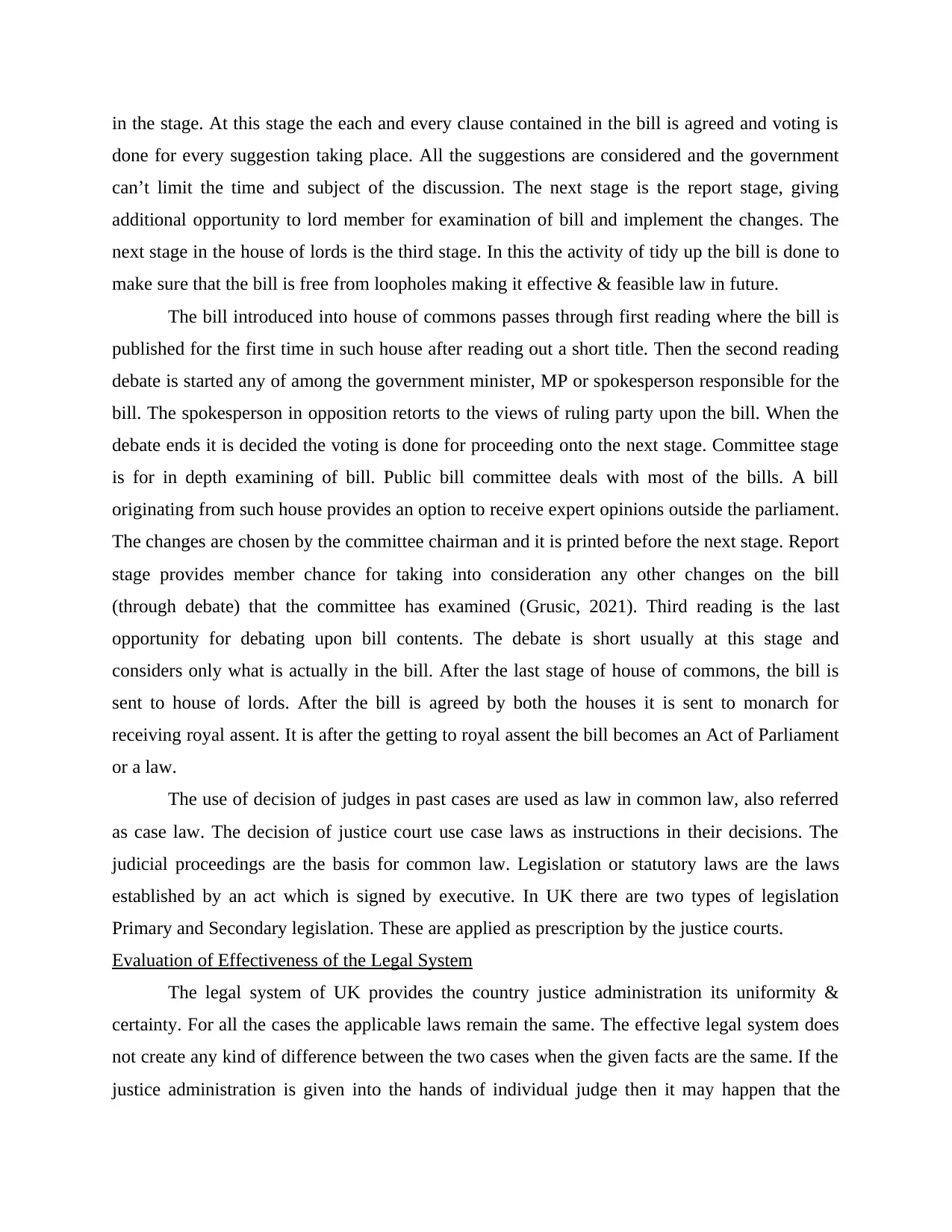
in the stage. At this stage the each and every clause contained in the bill is agreed and voting is
done for every suggestion taking place. All the suggestions are considered and the government
can’t limit the time and subject of the discussion. The next stage is the report stage, giving
additional opportunity to lord member for examination of bill and implement the changes. The
next stage in the house of lords is the third stage. In this the activity of tidy up the bill is done to
make sure that the bill is free from loopholes making it effective & feasible law in future.
The bill introduced into house of commons passes through first reading where the bill is
published for the first time in such house after reading out a short title. Then the second reading
debate is started any of among the government minister, MP or spokesperson responsible for the
bill. The spokesperson in opposition retorts to the views of ruling party upon the bill. When the
debate ends it is decided the voting is done for proceeding onto the next stage. Committee stage
is for in depth examining of bill. Public bill committee deals with most of the bills. A bill
originating from such house provides an option to receive expert opinions outside the parliament.
The changes are chosen by the committee chairman and it is printed before the next stage. Report
stage provides member chance for taking into consideration any other changes on the bill
(through debate) that the committee has examined (Grusic, 2021). Third reading is the last
opportunity for debating upon bill contents. The debate is short usually at this stage and
considers only what is actually in the bill. After the last stage of house of commons, the bill is
sent to house of lords. After the bill is agreed by both the houses it is sent to monarch for
receiving royal assent. It is after the getting to royal assent the bill becomes an Act of Parliament
or a law.
The use of decision of judges in past cases are used as law in common law, also referred
as case law. The decision of justice court use case laws as instructions in their decisions. The
judicial proceedings are the basis for common law. Legislation or statutory laws are the laws
established by an act which is signed by executive. In UK there are two types of legislation
Primary and Secondary legislation. These are applied as prescription by the justice courts.
Evaluation of Effectiveness of the Legal System
The legal system of UK provides the country justice administration its uniformity &
certainty. For all the cases the applicable laws remain the same. The effective legal system does
not create any kind of difference between the two cases when the given facts are the same. If the
justice administration is given into the hands of individual judge then it may happen that the
done for every suggestion taking place. All the suggestions are considered and the government
can’t limit the time and subject of the discussion. The next stage is the report stage, giving
additional opportunity to lord member for examination of bill and implement the changes. The
next stage in the house of lords is the third stage. In this the activity of tidy up the bill is done to
make sure that the bill is free from loopholes making it effective & feasible law in future.
The bill introduced into house of commons passes through first reading where the bill is
published for the first time in such house after reading out a short title. Then the second reading
debate is started any of among the government minister, MP or spokesperson responsible for the
bill. The spokesperson in opposition retorts to the views of ruling party upon the bill. When the
debate ends it is decided the voting is done for proceeding onto the next stage. Committee stage
is for in depth examining of bill. Public bill committee deals with most of the bills. A bill
originating from such house provides an option to receive expert opinions outside the parliament.
The changes are chosen by the committee chairman and it is printed before the next stage. Report
stage provides member chance for taking into consideration any other changes on the bill
(through debate) that the committee has examined (Grusic, 2021). Third reading is the last
opportunity for debating upon bill contents. The debate is short usually at this stage and
considers only what is actually in the bill. After the last stage of house of commons, the bill is
sent to house of lords. After the bill is agreed by both the houses it is sent to monarch for
receiving royal assent. It is after the getting to royal assent the bill becomes an Act of Parliament
or a law.
The use of decision of judges in past cases are used as law in common law, also referred
as case law. The decision of justice court use case laws as instructions in their decisions. The
judicial proceedings are the basis for common law. Legislation or statutory laws are the laws
established by an act which is signed by executive. In UK there are two types of legislation
Primary and Secondary legislation. These are applied as prescription by the justice courts.
Evaluation of Effectiveness of the Legal System
The legal system of UK provides the country justice administration its uniformity &
certainty. For all the cases the applicable laws remain the same. The effective legal system does
not create any kind of difference between the two cases when the given facts are the same. If the
justice administration is given into the hands of individual judge then it may happen that the
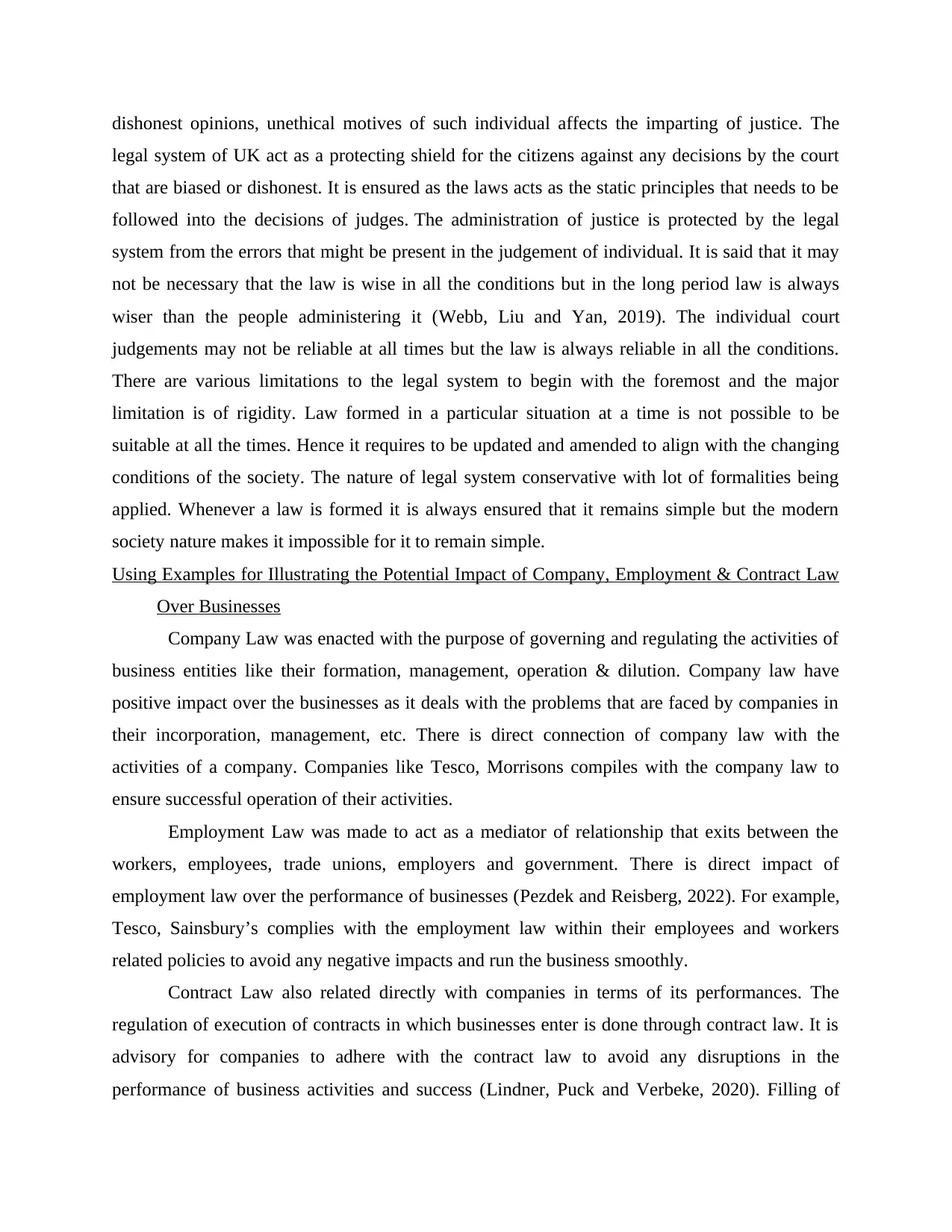
dishonest opinions, unethical motives of such individual affects the imparting of justice. The
legal system of UK act as a protecting shield for the citizens against any decisions by the court
that are biased or dishonest. It is ensured as the laws acts as the static principles that needs to be
followed into the decisions of judges. The administration of justice is protected by the legal
system from the errors that might be present in the judgement of individual. It is said that it may
not be necessary that the law is wise in all the conditions but in the long period law is always
wiser than the people administering it (Webb, Liu and Yan, 2019). The individual court
judgements may not be reliable at all times but the law is always reliable in all the conditions.
There are various limitations to the legal system to begin with the foremost and the major
limitation is of rigidity. Law formed in a particular situation at a time is not possible to be
suitable at all the times. Hence it requires to be updated and amended to align with the changing
conditions of the society. The nature of legal system conservative with lot of formalities being
applied. Whenever a law is formed it is always ensured that it remains simple but the modern
society nature makes it impossible for it to remain simple.
Using Examples for Illustrating the Potential Impact of Company, Employment & Contract Law
Over Businesses
Company Law was enacted with the purpose of governing and regulating the activities of
business entities like their formation, management, operation & dilution. Company law have
positive impact over the businesses as it deals with the problems that are faced by companies in
their incorporation, management, etc. There is direct connection of company law with the
activities of a company. Companies like Tesco, Morrisons compiles with the company law to
ensure successful operation of their activities.
Employment Law was made to act as a mediator of relationship that exits between the
workers, employees, trade unions, employers and government. There is direct impact of
employment law over the performance of businesses (Pezdek and Reisberg, 2022). For example,
Tesco, Sainsbury’s complies with the employment law within their employees and workers
related policies to avoid any negative impacts and run the business smoothly.
Contract Law also related directly with companies in terms of its performances. The
regulation of execution of contracts in which businesses enter is done through contract law. It is
advisory for companies to adhere with the contract law to avoid any disruptions in the
performance of business activities and success (Lindner, Puck and Verbeke, 2020). Filling of
legal system of UK act as a protecting shield for the citizens against any decisions by the court
that are biased or dishonest. It is ensured as the laws acts as the static principles that needs to be
followed into the decisions of judges. The administration of justice is protected by the legal
system from the errors that might be present in the judgement of individual. It is said that it may
not be necessary that the law is wise in all the conditions but in the long period law is always
wiser than the people administering it (Webb, Liu and Yan, 2019). The individual court
judgements may not be reliable at all times but the law is always reliable in all the conditions.
There are various limitations to the legal system to begin with the foremost and the major
limitation is of rigidity. Law formed in a particular situation at a time is not possible to be
suitable at all the times. Hence it requires to be updated and amended to align with the changing
conditions of the society. The nature of legal system conservative with lot of formalities being
applied. Whenever a law is formed it is always ensured that it remains simple but the modern
society nature makes it impossible for it to remain simple.
Using Examples for Illustrating the Potential Impact of Company, Employment & Contract Law
Over Businesses
Company Law was enacted with the purpose of governing and regulating the activities of
business entities like their formation, management, operation & dilution. Company law have
positive impact over the businesses as it deals with the problems that are faced by companies in
their incorporation, management, etc. There is direct connection of company law with the
activities of a company. Companies like Tesco, Morrisons compiles with the company law to
ensure successful operation of their activities.
Employment Law was made to act as a mediator of relationship that exits between the
workers, employees, trade unions, employers and government. There is direct impact of
employment law over the performance of businesses (Pezdek and Reisberg, 2022). For example,
Tesco, Sainsbury’s complies with the employment law within their employees and workers
related policies to avoid any negative impacts and run the business smoothly.
Contract Law also related directly with companies in terms of its performances. The
regulation of execution of contracts in which businesses enter is done through contract law. It is
advisory for companies to adhere with the contract law to avoid any disruptions in the
performance of business activities and success (Lindner, Puck and Verbeke, 2020). Filling of
⊘ This is a preview!⊘
Do you want full access?
Subscribe today to unlock all pages.

Trusted by 1+ million students worldwide
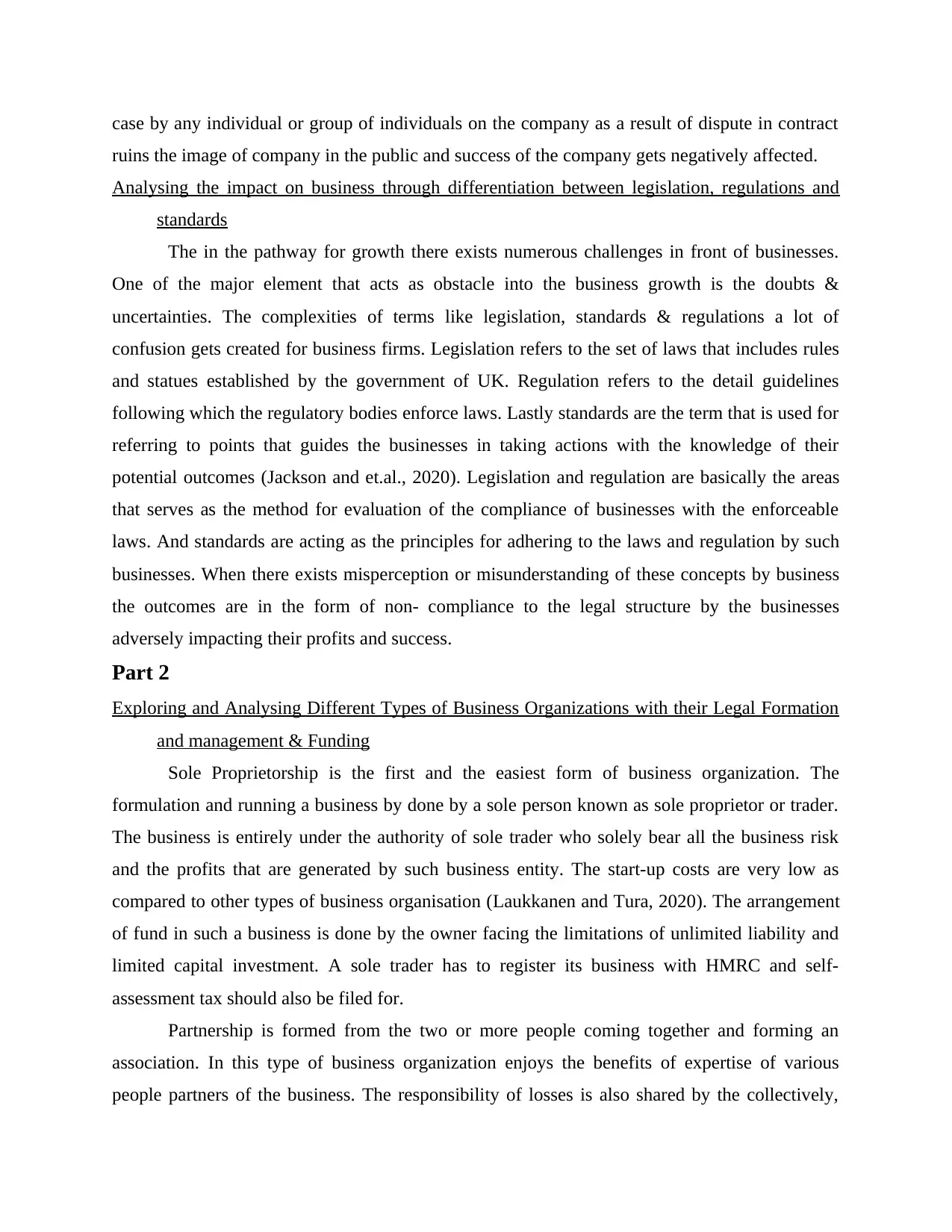
case by any individual or group of individuals on the company as a result of dispute in contract
ruins the image of company in the public and success of the company gets negatively affected.
Analysing the impact on business through differentiation between legislation, regulations and
standards
The in the pathway for growth there exists numerous challenges in front of businesses.
One of the major element that acts as obstacle into the business growth is the doubts &
uncertainties. The complexities of terms like legislation, standards & regulations a lot of
confusion gets created for business firms. Legislation refers to the set of laws that includes rules
and statues established by the government of UK. Regulation refers to the detail guidelines
following which the regulatory bodies enforce laws. Lastly standards are the term that is used for
referring to points that guides the businesses in taking actions with the knowledge of their
potential outcomes (Jackson and et.al., 2020). Legislation and regulation are basically the areas
that serves as the method for evaluation of the compliance of businesses with the enforceable
laws. And standards are acting as the principles for adhering to the laws and regulation by such
businesses. When there exists misperception or misunderstanding of these concepts by business
the outcomes are in the form of non- compliance to the legal structure by the businesses
adversely impacting their profits and success.
Part 2
Exploring and Analysing Different Types of Business Organizations with their Legal Formation
and management & Funding
Sole Proprietorship is the first and the easiest form of business organization. The
formulation and running a business by done by a sole person known as sole proprietor or trader.
The business is entirely under the authority of sole trader who solely bear all the business risk
and the profits that are generated by such business entity. The start-up costs are very low as
compared to other types of business organisation (Laukkanen and Tura, 2020). The arrangement
of fund in such a business is done by the owner facing the limitations of unlimited liability and
limited capital investment. A sole trader has to register its business with HMRC and self-
assessment tax should also be filed for.
Partnership is formed from the two or more people coming together and forming an
association. In this type of business organization enjoys the benefits of expertise of various
people partners of the business. The responsibility of losses is also shared by the collectively,
ruins the image of company in the public and success of the company gets negatively affected.
Analysing the impact on business through differentiation between legislation, regulations and
standards
The in the pathway for growth there exists numerous challenges in front of businesses.
One of the major element that acts as obstacle into the business growth is the doubts &
uncertainties. The complexities of terms like legislation, standards & regulations a lot of
confusion gets created for business firms. Legislation refers to the set of laws that includes rules
and statues established by the government of UK. Regulation refers to the detail guidelines
following which the regulatory bodies enforce laws. Lastly standards are the term that is used for
referring to points that guides the businesses in taking actions with the knowledge of their
potential outcomes (Jackson and et.al., 2020). Legislation and regulation are basically the areas
that serves as the method for evaluation of the compliance of businesses with the enforceable
laws. And standards are acting as the principles for adhering to the laws and regulation by such
businesses. When there exists misperception or misunderstanding of these concepts by business
the outcomes are in the form of non- compliance to the legal structure by the businesses
adversely impacting their profits and success.
Part 2
Exploring and Analysing Different Types of Business Organizations with their Legal Formation
and management & Funding
Sole Proprietorship is the first and the easiest form of business organization. The
formulation and running a business by done by a sole person known as sole proprietor or trader.
The business is entirely under the authority of sole trader who solely bear all the business risk
and the profits that are generated by such business entity. The start-up costs are very low as
compared to other types of business organisation (Laukkanen and Tura, 2020). The arrangement
of fund in such a business is done by the owner facing the limitations of unlimited liability and
limited capital investment. A sole trader has to register its business with HMRC and self-
assessment tax should also be filed for.
Partnership is formed from the two or more people coming together and forming an
association. In this type of business organization enjoys the benefits of expertise of various
people partners of the business. The responsibility of losses is also shared by the collectively,
Paraphrase This Document
Need a fresh take? Get an instant paraphrase of this document with our AI Paraphraser
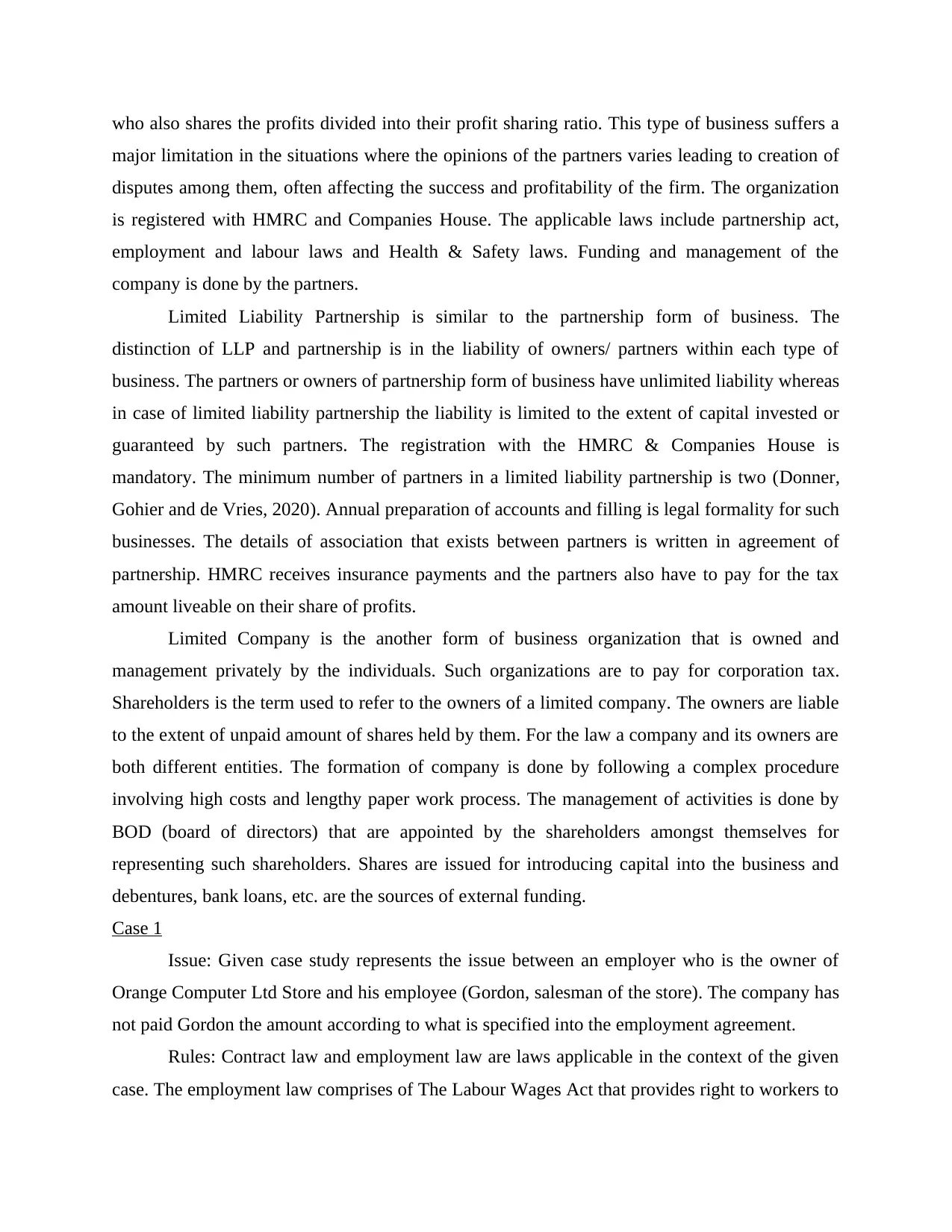
who also shares the profits divided into their profit sharing ratio. This type of business suffers a
major limitation in the situations where the opinions of the partners varies leading to creation of
disputes among them, often affecting the success and profitability of the firm. The organization
is registered with HMRC and Companies House. The applicable laws include partnership act,
employment and labour laws and Health & Safety laws. Funding and management of the
company is done by the partners.
Limited Liability Partnership is similar to the partnership form of business. The
distinction of LLP and partnership is in the liability of owners/ partners within each type of
business. The partners or owners of partnership form of business have unlimited liability whereas
in case of limited liability partnership the liability is limited to the extent of capital invested or
guaranteed by such partners. The registration with the HMRC & Companies House is
mandatory. The minimum number of partners in a limited liability partnership is two (Donner,
Gohier and de Vries, 2020). Annual preparation of accounts and filling is legal formality for such
businesses. The details of association that exists between partners is written in agreement of
partnership. HMRC receives insurance payments and the partners also have to pay for the tax
amount liveable on their share of profits.
Limited Company is the another form of business organization that is owned and
management privately by the individuals. Such organizations are to pay for corporation tax.
Shareholders is the term used to refer to the owners of a limited company. The owners are liable
to the extent of unpaid amount of shares held by them. For the law a company and its owners are
both different entities. The formation of company is done by following a complex procedure
involving high costs and lengthy paper work process. The management of activities is done by
BOD (board of directors) that are appointed by the shareholders amongst themselves for
representing such shareholders. Shares are issued for introducing capital into the business and
debentures, bank loans, etc. are the sources of external funding.
Case 1
Issue: Given case study represents the issue between an employer who is the owner of
Orange Computer Ltd Store and his employee (Gordon, salesman of the store). The company has
not paid Gordon the amount according to what is specified into the employment agreement.
Rules: Contract law and employment law are laws applicable in the context of the given
case. The employment law comprises of The Labour Wages Act that provides right to workers to
major limitation in the situations where the opinions of the partners varies leading to creation of
disputes among them, often affecting the success and profitability of the firm. The organization
is registered with HMRC and Companies House. The applicable laws include partnership act,
employment and labour laws and Health & Safety laws. Funding and management of the
company is done by the partners.
Limited Liability Partnership is similar to the partnership form of business. The
distinction of LLP and partnership is in the liability of owners/ partners within each type of
business. The partners or owners of partnership form of business have unlimited liability whereas
in case of limited liability partnership the liability is limited to the extent of capital invested or
guaranteed by such partners. The registration with the HMRC & Companies House is
mandatory. The minimum number of partners in a limited liability partnership is two (Donner,
Gohier and de Vries, 2020). Annual preparation of accounts and filling is legal formality for such
businesses. The details of association that exists between partners is written in agreement of
partnership. HMRC receives insurance payments and the partners also have to pay for the tax
amount liveable on their share of profits.
Limited Company is the another form of business organization that is owned and
management privately by the individuals. Such organizations are to pay for corporation tax.
Shareholders is the term used to refer to the owners of a limited company. The owners are liable
to the extent of unpaid amount of shares held by them. For the law a company and its owners are
both different entities. The formation of company is done by following a complex procedure
involving high costs and lengthy paper work process. The management of activities is done by
BOD (board of directors) that are appointed by the shareholders amongst themselves for
representing such shareholders. Shares are issued for introducing capital into the business and
debentures, bank loans, etc. are the sources of external funding.
Case 1
Issue: Given case study represents the issue between an employer who is the owner of
Orange Computer Ltd Store and his employee (Gordon, salesman of the store). The company has
not paid Gordon the amount according to what is specified into the employment agreement.
Rules: Contract law and employment law are laws applicable in the context of the given
case. The employment law comprises of The Labour Wages Act that provides right to workers to
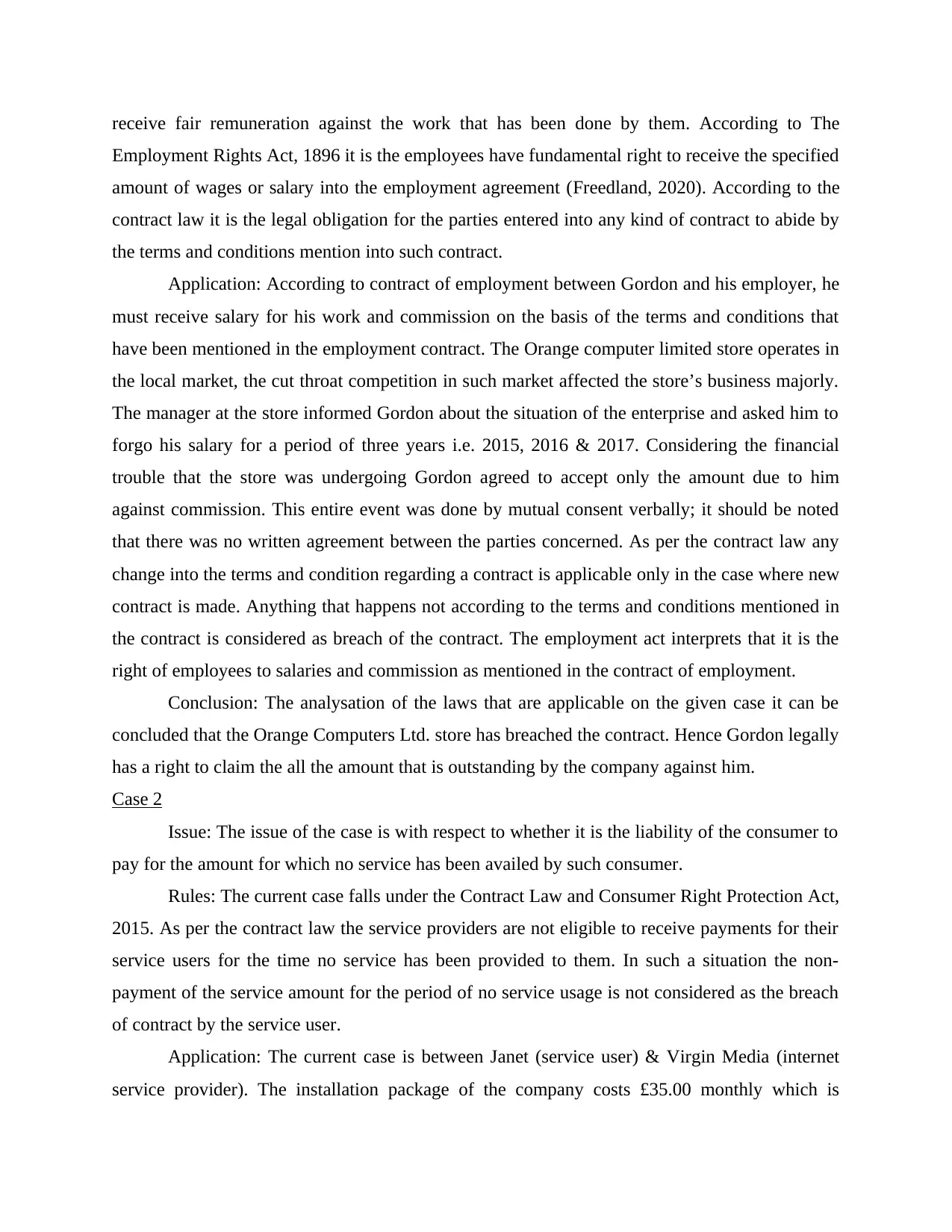
receive fair remuneration against the work that has been done by them. According to The
Employment Rights Act, 1896 it is the employees have fundamental right to receive the specified
amount of wages or salary into the employment agreement (Freedland, 2020). According to the
contract law it is the legal obligation for the parties entered into any kind of contract to abide by
the terms and conditions mention into such contract.
Application: According to contract of employment between Gordon and his employer, he
must receive salary for his work and commission on the basis of the terms and conditions that
have been mentioned in the employment contract. The Orange computer limited store operates in
the local market, the cut throat competition in such market affected the store’s business majorly.
The manager at the store informed Gordon about the situation of the enterprise and asked him to
forgo his salary for a period of three years i.e. 2015, 2016 & 2017. Considering the financial
trouble that the store was undergoing Gordon agreed to accept only the amount due to him
against commission. This entire event was done by mutual consent verbally; it should be noted
that there was no written agreement between the parties concerned. As per the contract law any
change into the terms and condition regarding a contract is applicable only in the case where new
contract is made. Anything that happens not according to the terms and conditions mentioned in
the contract is considered as breach of the contract. The employment act interprets that it is the
right of employees to salaries and commission as mentioned in the contract of employment.
Conclusion: The analysation of the laws that are applicable on the given case it can be
concluded that the Orange Computers Ltd. store has breached the contract. Hence Gordon legally
has a right to claim the all the amount that is outstanding by the company against him.
Case 2
Issue: The issue of the case is with respect to whether it is the liability of the consumer to
pay for the amount for which no service has been availed by such consumer.
Rules: The current case falls under the Contract Law and Consumer Right Protection Act,
2015. As per the contract law the service providers are not eligible to receive payments for their
service users for the time no service has been provided to them. In such a situation the non-
payment of the service amount for the period of no service usage is not considered as the breach
of contract by the service user.
Application: The current case is between Janet (service user) & Virgin Media (internet
service provider). The installation package of the company costs £35.00 monthly which is
Employment Rights Act, 1896 it is the employees have fundamental right to receive the specified
amount of wages or salary into the employment agreement (Freedland, 2020). According to the
contract law it is the legal obligation for the parties entered into any kind of contract to abide by
the terms and conditions mention into such contract.
Application: According to contract of employment between Gordon and his employer, he
must receive salary for his work and commission on the basis of the terms and conditions that
have been mentioned in the employment contract. The Orange computer limited store operates in
the local market, the cut throat competition in such market affected the store’s business majorly.
The manager at the store informed Gordon about the situation of the enterprise and asked him to
forgo his salary for a period of three years i.e. 2015, 2016 & 2017. Considering the financial
trouble that the store was undergoing Gordon agreed to accept only the amount due to him
against commission. This entire event was done by mutual consent verbally; it should be noted
that there was no written agreement between the parties concerned. As per the contract law any
change into the terms and condition regarding a contract is applicable only in the case where new
contract is made. Anything that happens not according to the terms and conditions mentioned in
the contract is considered as breach of the contract. The employment act interprets that it is the
right of employees to salaries and commission as mentioned in the contract of employment.
Conclusion: The analysation of the laws that are applicable on the given case it can be
concluded that the Orange Computers Ltd. store has breached the contract. Hence Gordon legally
has a right to claim the all the amount that is outstanding by the company against him.
Case 2
Issue: The issue of the case is with respect to whether it is the liability of the consumer to
pay for the amount for which no service has been availed by such consumer.
Rules: The current case falls under the Contract Law and Consumer Right Protection Act,
2015. As per the contract law the service providers are not eligible to receive payments for their
service users for the time no service has been provided to them. In such a situation the non-
payment of the service amount for the period of no service usage is not considered as the breach
of contract by the service user.
Application: The current case is between Janet (service user) & Virgin Media (internet
service provider). The installation package of the company costs £35.00 monthly which is
⊘ This is a preview!⊘
Do you want full access?
Subscribe today to unlock all pages.

Trusted by 1+ million students worldwide
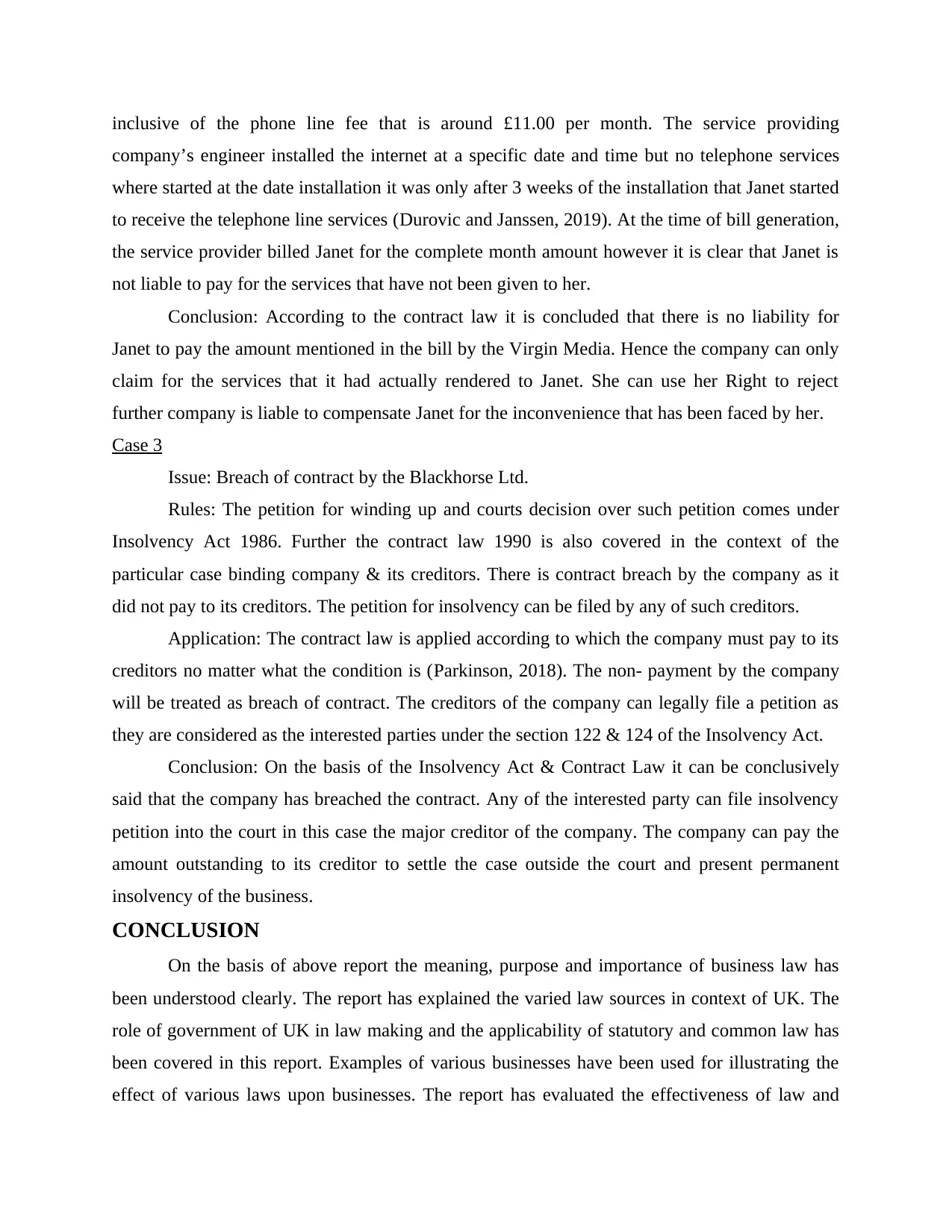
inclusive of the phone line fee that is around £11.00 per month. The service providing
company’s engineer installed the internet at a specific date and time but no telephone services
where started at the date installation it was only after 3 weeks of the installation that Janet started
to receive the telephone line services (Durovic and Janssen, 2019). At the time of bill generation,
the service provider billed Janet for the complete month amount however it is clear that Janet is
not liable to pay for the services that have not been given to her.
Conclusion: According to the contract law it is concluded that there is no liability for
Janet to pay the amount mentioned in the bill by the Virgin Media. Hence the company can only
claim for the services that it had actually rendered to Janet. She can use her Right to reject
further company is liable to compensate Janet for the inconvenience that has been faced by her.
Case 3
Issue: Breach of contract by the Blackhorse Ltd.
Rules: The petition for winding up and courts decision over such petition comes under
Insolvency Act 1986. Further the contract law 1990 is also covered in the context of the
particular case binding company & its creditors. There is contract breach by the company as it
did not pay to its creditors. The petition for insolvency can be filed by any of such creditors.
Application: The contract law is applied according to which the company must pay to its
creditors no matter what the condition is (Parkinson, 2018). The non- payment by the company
will be treated as breach of contract. The creditors of the company can legally file a petition as
they are considered as the interested parties under the section 122 & 124 of the Insolvency Act.
Conclusion: On the basis of the Insolvency Act & Contract Law it can be conclusively
said that the company has breached the contract. Any of the interested party can file insolvency
petition into the court in this case the major creditor of the company. The company can pay the
amount outstanding to its creditor to settle the case outside the court and present permanent
insolvency of the business.
CONCLUSION
On the basis of above report the meaning, purpose and importance of business law has
been understood clearly. The report has explained the varied law sources in context of UK. The
role of government of UK in law making and the applicability of statutory and common law has
been covered in this report. Examples of various businesses have been used for illustrating the
effect of various laws upon businesses. The report has evaluated the effectiveness of law and
company’s engineer installed the internet at a specific date and time but no telephone services
where started at the date installation it was only after 3 weeks of the installation that Janet started
to receive the telephone line services (Durovic and Janssen, 2019). At the time of bill generation,
the service provider billed Janet for the complete month amount however it is clear that Janet is
not liable to pay for the services that have not been given to her.
Conclusion: According to the contract law it is concluded that there is no liability for
Janet to pay the amount mentioned in the bill by the Virgin Media. Hence the company can only
claim for the services that it had actually rendered to Janet. She can use her Right to reject
further company is liable to compensate Janet for the inconvenience that has been faced by her.
Case 3
Issue: Breach of contract by the Blackhorse Ltd.
Rules: The petition for winding up and courts decision over such petition comes under
Insolvency Act 1986. Further the contract law 1990 is also covered in the context of the
particular case binding company & its creditors. There is contract breach by the company as it
did not pay to its creditors. The petition for insolvency can be filed by any of such creditors.
Application: The contract law is applied according to which the company must pay to its
creditors no matter what the condition is (Parkinson, 2018). The non- payment by the company
will be treated as breach of contract. The creditors of the company can legally file a petition as
they are considered as the interested parties under the section 122 & 124 of the Insolvency Act.
Conclusion: On the basis of the Insolvency Act & Contract Law it can be conclusively
said that the company has breached the contract. Any of the interested party can file insolvency
petition into the court in this case the major creditor of the company. The company can pay the
amount outstanding to its creditor to settle the case outside the court and present permanent
insolvency of the business.
CONCLUSION
On the basis of above report the meaning, purpose and importance of business law has
been understood clearly. The report has explained the varied law sources in context of UK. The
role of government of UK in law making and the applicability of statutory and common law has
been covered in this report. Examples of various businesses have been used for illustrating the
effect of various laws upon businesses. The report has evaluated the effectiveness of law and
Paraphrase This Document
Need a fresh take? Get an instant paraphrase of this document with our AI Paraphraser
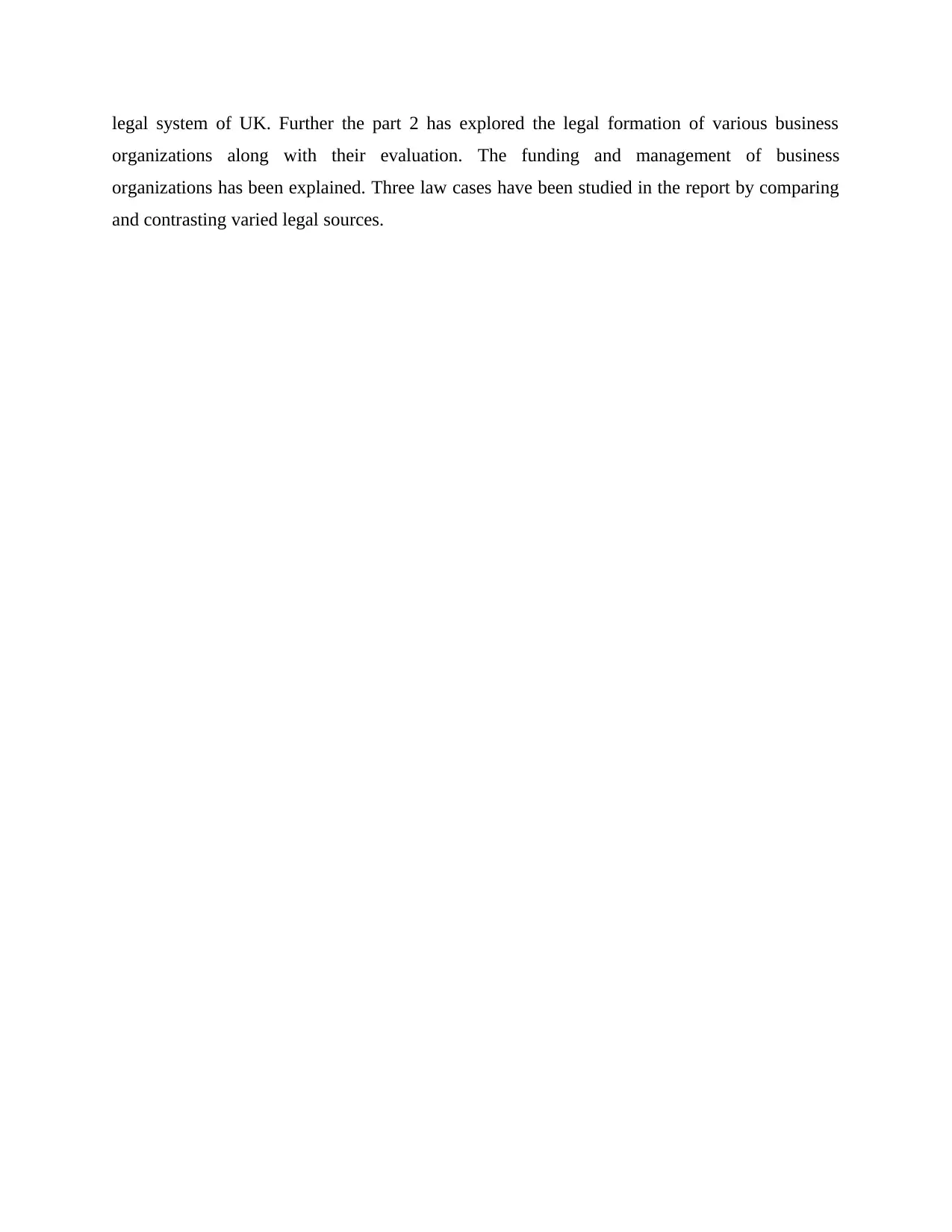
legal system of UK. Further the part 2 has explored the legal formation of various business
organizations along with their evaluation. The funding and management of business
organizations has been explained. Three law cases have been studied in the report by comparing
and contrasting varied legal sources.
organizations along with their evaluation. The funding and management of business
organizations has been explained. Three law cases have been studied in the report by comparing
and contrasting varied legal sources.
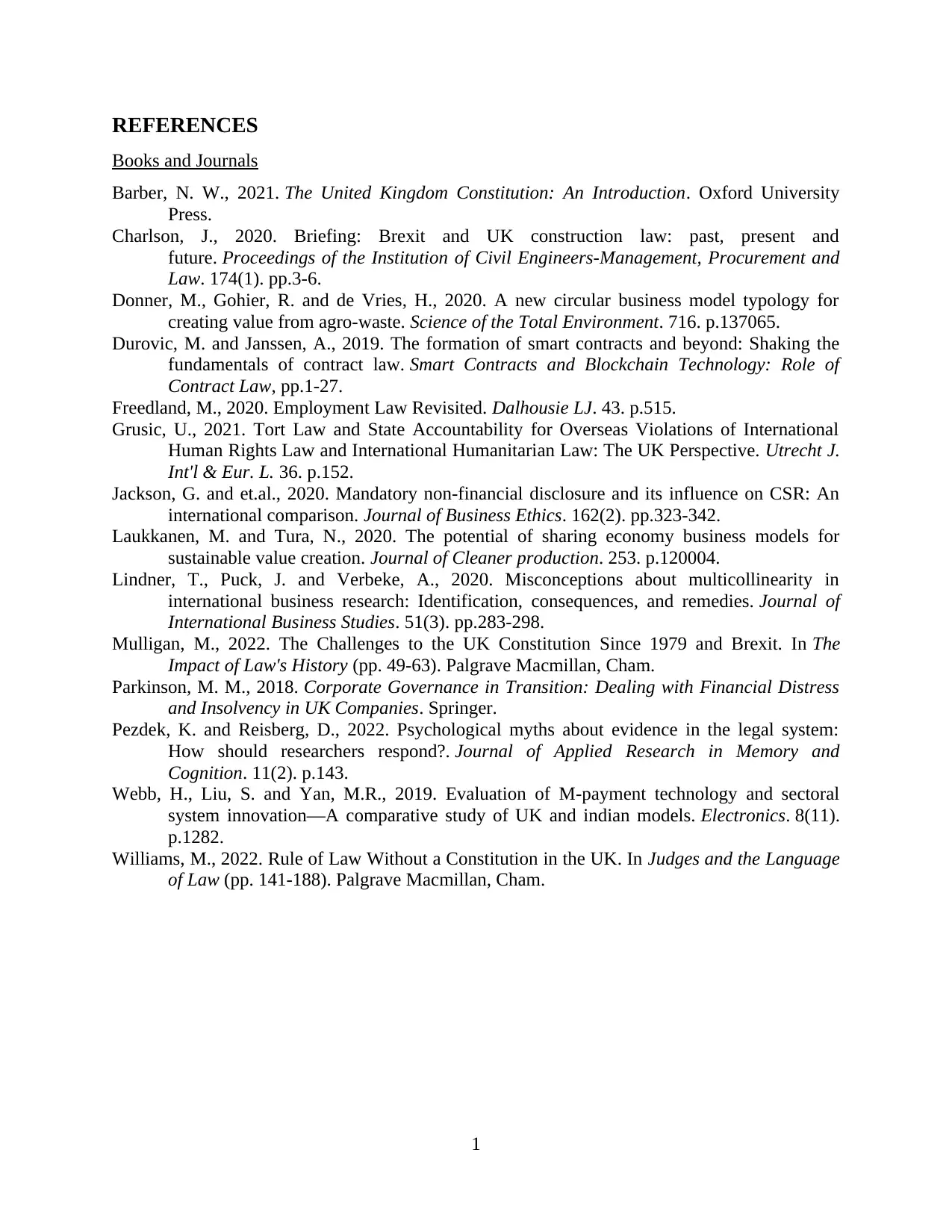
REFERENCES
Books and Journals
Barber, N. W., 2021. The United Kingdom Constitution: An Introduction. Oxford University
Press.
Charlson, J., 2020. Briefing: Brexit and UK construction law: past, present and
future. Proceedings of the Institution of Civil Engineers-Management, Procurement and
Law. 174(1). pp.3-6.
Donner, M., Gohier, R. and de Vries, H., 2020. A new circular business model typology for
creating value from agro-waste. Science of the Total Environment. 716. p.137065.
Durovic, M. and Janssen, A., 2019. The formation of smart contracts and beyond: Shaking the
fundamentals of contract law. Smart Contracts and Blockchain Technology: Role of
Contract Law, pp.1-27.
Freedland, M., 2020. Employment Law Revisited. Dalhousie LJ. 43. p.515.
Grusic, U., 2021. Tort Law and State Accountability for Overseas Violations of International
Human Rights Law and International Humanitarian Law: The UK Perspective. Utrecht J.
Int'l & Eur. L. 36. p.152.
Jackson, G. and et.al., 2020. Mandatory non-financial disclosure and its influence on CSR: An
international comparison. Journal of Business Ethics. 162(2). pp.323-342.
Laukkanen, M. and Tura, N., 2020. The potential of sharing economy business models for
sustainable value creation. Journal of Cleaner production. 253. p.120004.
Lindner, T., Puck, J. and Verbeke, A., 2020. Misconceptions about multicollinearity in
international business research: Identification, consequences, and remedies. Journal of
International Business Studies. 51(3). pp.283-298.
Mulligan, M., 2022. The Challenges to the UK Constitution Since 1979 and Brexit. In The
Impact of Law's History (pp. 49-63). Palgrave Macmillan, Cham.
Parkinson, M. M., 2018. Corporate Governance in Transition: Dealing with Financial Distress
and Insolvency in UK Companies. Springer.
Pezdek, K. and Reisberg, D., 2022. Psychological myths about evidence in the legal system:
How should researchers respond?. Journal of Applied Research in Memory and
Cognition. 11(2). p.143.
Webb, H., Liu, S. and Yan, M.R., 2019. Evaluation of M-payment technology and sectoral
system innovation—A comparative study of UK and indian models. Electronics. 8(11).
p.1282.
Williams, M., 2022. Rule of Law Without a Constitution in the UK. In Judges and the Language
of Law (pp. 141-188). Palgrave Macmillan, Cham.
1
Books and Journals
Barber, N. W., 2021. The United Kingdom Constitution: An Introduction. Oxford University
Press.
Charlson, J., 2020. Briefing: Brexit and UK construction law: past, present and
future. Proceedings of the Institution of Civil Engineers-Management, Procurement and
Law. 174(1). pp.3-6.
Donner, M., Gohier, R. and de Vries, H., 2020. A new circular business model typology for
creating value from agro-waste. Science of the Total Environment. 716. p.137065.
Durovic, M. and Janssen, A., 2019. The formation of smart contracts and beyond: Shaking the
fundamentals of contract law. Smart Contracts and Blockchain Technology: Role of
Contract Law, pp.1-27.
Freedland, M., 2020. Employment Law Revisited. Dalhousie LJ. 43. p.515.
Grusic, U., 2021. Tort Law and State Accountability for Overseas Violations of International
Human Rights Law and International Humanitarian Law: The UK Perspective. Utrecht J.
Int'l & Eur. L. 36. p.152.
Jackson, G. and et.al., 2020. Mandatory non-financial disclosure and its influence on CSR: An
international comparison. Journal of Business Ethics. 162(2). pp.323-342.
Laukkanen, M. and Tura, N., 2020. The potential of sharing economy business models for
sustainable value creation. Journal of Cleaner production. 253. p.120004.
Lindner, T., Puck, J. and Verbeke, A., 2020. Misconceptions about multicollinearity in
international business research: Identification, consequences, and remedies. Journal of
International Business Studies. 51(3). pp.283-298.
Mulligan, M., 2022. The Challenges to the UK Constitution Since 1979 and Brexit. In The
Impact of Law's History (pp. 49-63). Palgrave Macmillan, Cham.
Parkinson, M. M., 2018. Corporate Governance in Transition: Dealing with Financial Distress
and Insolvency in UK Companies. Springer.
Pezdek, K. and Reisberg, D., 2022. Psychological myths about evidence in the legal system:
How should researchers respond?. Journal of Applied Research in Memory and
Cognition. 11(2). p.143.
Webb, H., Liu, S. and Yan, M.R., 2019. Evaluation of M-payment technology and sectoral
system innovation—A comparative study of UK and indian models. Electronics. 8(11).
p.1282.
Williams, M., 2022. Rule of Law Without a Constitution in the UK. In Judges and the Language
of Law (pp. 141-188). Palgrave Macmillan, Cham.
1
⊘ This is a preview!⊘
Do you want full access?
Subscribe today to unlock all pages.

Trusted by 1+ million students worldwide
1 out of 12
Related Documents
Your All-in-One AI-Powered Toolkit for Academic Success.
+13062052269
info@desklib.com
Available 24*7 on WhatsApp / Email
![[object Object]](/_next/static/media/star-bottom.7253800d.svg)
Unlock your academic potential
Copyright © 2020–2025 A2Z Services. All Rights Reserved. Developed and managed by ZUCOL.





